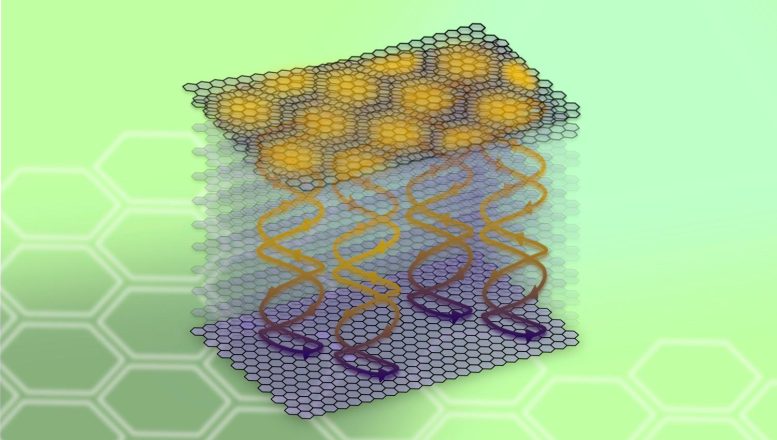
A University of Washington-led team has discovered that, by stacking a sheet of graphene onto bulk graphite at a small twist angle (top), “exotic” properties present at the graphene-graphite interface (yellow) can bleed down into the graphite itself. Credit: Ellis Thompson
A breakthrough study by the University of Washington has shown that graphite, a 3D material, can be manipulated to possess properties of its 2D counterpart, graphene. This paves the way for the potential modification of other bulk materials to exhibit 2D-like properties, potentially expanding the frontier for technological innovations.
Exploring the Potential of 2D Materials
For many years, scientists have explored the potential of two-dimensional materials, which consist of a single layer of atoms, to revolutionize various fields such as computing, communication, and energy. Within these materials, subatomic particles like electrons can only move in two dimensions, leading to unusual electron behavior and so-called “exotic” properties. These include bizarre forms of magnetism, superconductivity, and other collective behaviors among electrons — all of which could be useful in computing, communication, energy, and other fields.
Traditionally, researchers have assumed that these exotic 2D properties only exist in single-layer sheets or short stacks, with so-called “bulk” versions of these materials exhibiting different behaviors due to their complex 3D atomic structures.
An Unexpected Breakthrough in 2D Materials
Contrary to the above assumption, a groundbreaking study published on July 19 in Nature by a team led by the University of Washington demonstrated that it is possible to endow graphite, a bulk, 3D material found in everyday pencils, with properties akin to its 2D counterpart, graphene. Not only was this breakthrough unexpected, the team also believes its approach could be used to test whether similar types of bulk materials can also take on 2D-like properties. If so, 2D sheets won’t be the only source for scientists to fuel technological revolutions. Bulk, 3D materials could be just as useful.
“Stacking single layer on single layer — or two layers on two layers — has been the focus for unlocking new physics in 2D materials for several years now. In these experimental approaches, that’s where many interesting properties emerge,” said senior author Matthew Yankowitz, a UW assistant professor of physics and of materials science and engineering. “But what happens if you keep adding layers? Eventually, it has to stop, right? That’s what intuition suggests. But in this case, intuition is wrong. It’s possible to mix 2D properties into 3D materials.”
Exploring New Physics in 3D Materials
The research team, including scholars at Osaka University and the National Institute for Materials Science in Japan, adapted a common method for manipulating 2D materials. They stacked 2D sheets together at a small twist angle. The researchers placed a single layer of graphene atop a thin, bulk graphite crystal and introduced a twist angle of around 1 degree between the two. They found novel and unexpected electrical properties not just at the twisted interface but also within the bulk graphite.
The twist angle is critical to generating these properties, explained Yankowitz, who is also a faculty member at the UW Clean Energy Institute and the UW Institute for Nano-Engineered Systems. A twist angle between 2D sheets, like two sheets of graphene, creates what’s called a moiré pattern, which alters the flow of charged particles like electrons and induces exotic properties in the material.
Unprecedented Results and Future Possibilities
In experiments with graphite and graphene, the twist angle also induced a moiré pattern, yielding surprising results. A twist introduced only at the graphene-graphite interface changed the electrical properties of the whole graphite material. When a magnetic field was applied, electrons deep in the graphite crystal exhibited unusual properties similar to those at the twisted interface. Essentially, the single twisted graphene-graphite interface became inextricably mixed with the rest of the bulk graphite.
“Though we were generating the moiré pattern only at the surface of the graphite, the resulting properties were bleeding across the whole crystal,” said co-lead author Dacen Waters, a UW postdoctoral researcher in physics.
For 2D sheets, moiré patterns generate properties that could be useful for quantum computing and other applications. Inducing similar phenomena in 3D materials unlocks new approaches for studying unusual and exotic states of matter and how to bring them out of the laboratory and into our everyday lives.
“The entire crystal takes on this 2D state,” said co-lead author Ellis Thompson, a UW doctoral student in physics. “This is a fundamentally new way to affect electron behavior in a bulk material.”
Yankowitz and his team believe their approach of generating a twist angle between graphene and a bulk graphite crystal could be used to create 2D-3D hybrids of its sister materials, including tungsten ditelluride and zirconium pentatelluride. This could unlock a new approach to re-engineering the properties of conventional bulk materials using a single 2D interface.
“This method could become a really rich playground for studying exciting new physical phenomena in materials with mixed 2D and 3D properties,” said Yankowitz.
Reference: “Mixed-dimensional moire systems of twisted graphitic thin films” 19 July 2023, Nature.
DOI: 10.1038/s41586-023-06290-3
Co-authors on paper are UW graduate student Esmeralda Arreguin-Martinez and UW postdoctoral researcher Yafei Ren, both in the Department of Materials Science and Engineering; Ting Cao, a UW assistant professor of materials science and engineering; Di Xiao, a UW professor of physics and chair of materials science and engineering; Manato Fujimoto of Osaka University; and Kenji Watanabe and Takashi Taniguchi of the National Institute for Materials Science in Japan. The research was funded by the National Science Foundation; the U.S. Department of Energy; the UW Clean Energy Institute; the Office of the Director of National Intelligence; the Japan Science and Technology Agency; the Japan Society for the Promotion of Science; the Japanese Ministry of Education, Culture, Sports, Science and Technology; and the M.J. Murdock Charitable Trust.
Grant numbers:
- National Science Foundation: DMR-2041972, MRSEC-1719797, DGE-2140004
- U.S. Department of Energy: DE-SC0019443
- Japan Science and Technology Agency: JPMJCR20T3
- Japan Society for the Promotion of Science: JP21J10775, JP23KJ0339, 19H05790, 20H00354 and 21H05233
- Japanese Ministry of Education, Culture, Sports, Science and Technology: JPMXP0112101001

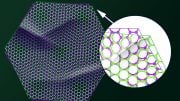




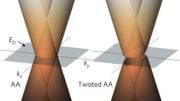
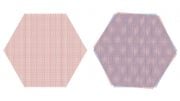
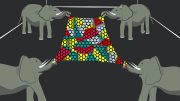
Low dimensional spatiotemporal matter is the foundation of high-dimensional spatiotemporal matter. The understanding for the low dimensional spatiotemporal matter must be guided by correct and scientific theoretical ideas.